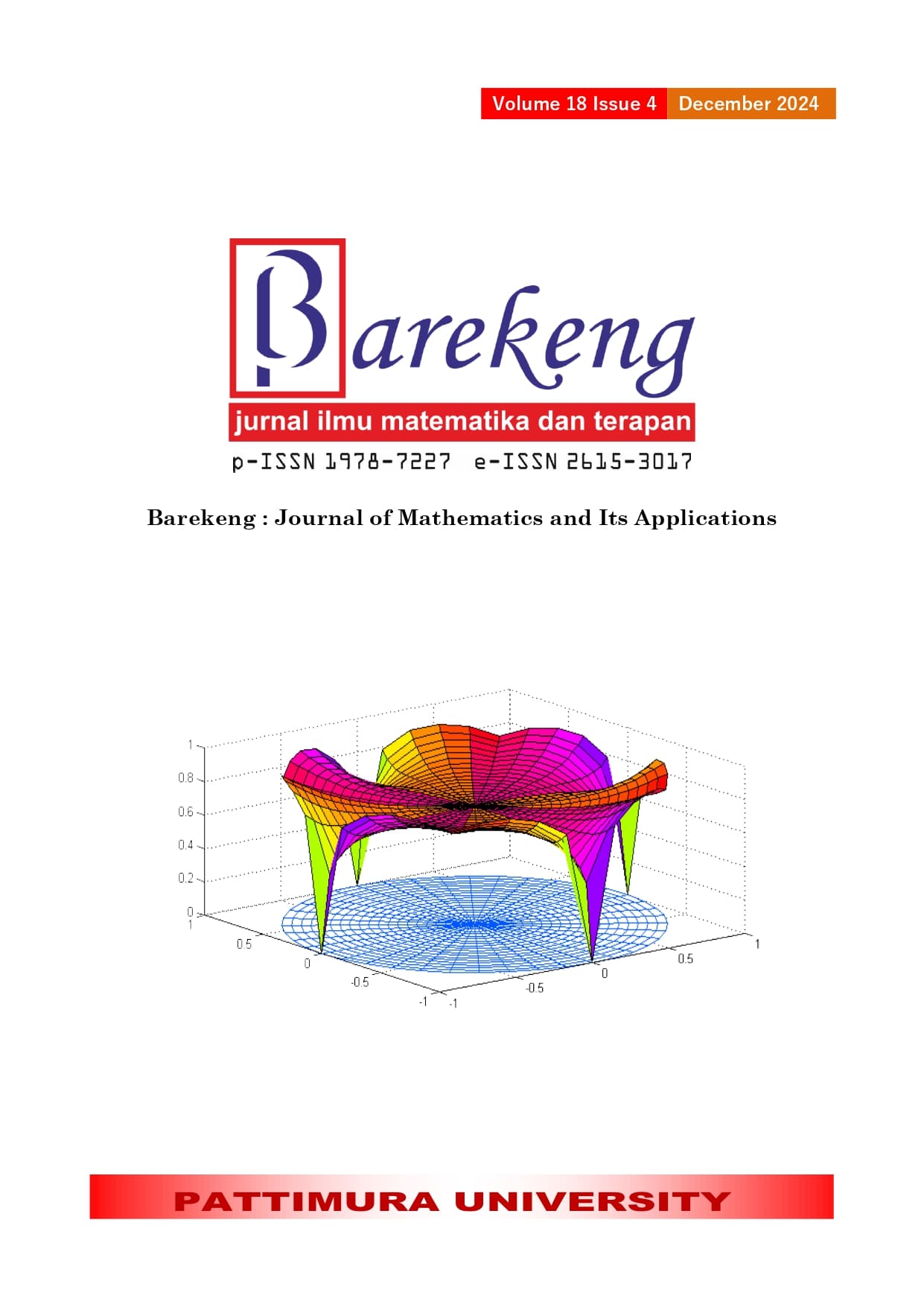COMPARATIVE ANALYSIS OF FUZZY TIME SERIES CHEN AND MARKOV CHAIN METHODS FOR FORECASTING ELECTRICITY CONSUMPTION IN MATARAM CITY
Abstract
The consumption of electrical energy continues to experience fluctuations every month, and these fluctuations cannot be accurately predicted. This uncertainty can become a problem if not projected and planned effectively. Therefore, PT PLN (Persero) needs to be able to provide and distribute electricity supply in an appropriate amount. This research aims to forecast electricity consumption based on historical data from January 2016 to April 2023 using the Fuzzy Time Series Chen (FTSC) method and the Fuzzy Time Series Markov Chain (FTSMC) method. The results of this research show that the forecast for May 2023 using the FTSC and FTSMC methods are 136.878.489 kWh and 143.498.523 kWh, respectively, with MAPE values of 11.61739% and 4.85428%, respectively. Therefore, forecasting in May 2023 using the FTSMC method is better than the FTSC method because the MAPE value is smaller.
Downloads
References
PLN, “Perusahaan Listrik Negara (PLN) Persero, Annual Report 2021,” Jakarta, 2021.
M. F. Lestari, H. Z. Abidin, and Rusminah, "Analisis Perbandingan Kinerja Karyawan PT. Perusahaan Listrik Negara (PLN) (Persero) Wilayah Nusa Tenggara Barat (Studi Kasus Pada Rayon Ampenen dan Rayon Cakranegara)," J.Distribusi, pp. 231-250, 2019, doi: 10.29303/distribusi.v7i2.87.
C. Chatfield, The Analysis of Time Series an Introduction Sixt Edition. New York: CHAPMAN & HALL/RC, 2017.
S. M. Chen, Forecasting Enrollments Based on Fuzzy Time Series, Fuzzy Sets and Systems. Elsevier, 1996.
R. C. Tsaur, “A fuzzy time series-Markov chain model with an application to forecast the exchange rate between the Taiwan and US dollar,” Int. J. Innov. Comput. Inf. Control, vol. 8, no. 7 B, pp. 4931–4942, 2012.
M. T. Jatipaningrum, “Peramalan Data Produk Domestik Bruto Dengan Fuzzy Time Series Markov Chain,” J. Teknol., pp. 31–38, 2016.
Q. Song and B. S. Chissom, “Fuzzy time series and its models,” Fuzzy Sets Syst., vol. 54, no. 3, pp. 269–277, 1993, doi: 10.1016/0165-0114(93)90372-O.
S. Makridakis and M. Hibon, Evaluating Accuracy (or error) measures. Insead Working PapersSeries 95/18/TM. France: Fontainable, 1995.
Y. e. Alyousifi, “Predicting Daily Air Pollution Index Based on Fuzzy Time Series Markov Chain Model,” J. Symmetry, pp. 2–18, 2020.
Arnita, N. Afnisah, and F. Marpaung, “A Comparison of the Fuzzy Time Series Methods of Chen, Cheng and Markov Chain in Predicting Rainfall in Medan,” J. Phys. Conf. Ser., vol. 1462, no. 1, 2020, doi: 10.1088/1742-6596/1462/1/012044.
B. P. Statistik, “Statistik Listrik 2020,” Jakarta, 2020.
R. Efendi, Z. Ismail, and M. M. Deris, “A new linguistic out-sample approach of fuzzy time series for daily forecasting of Malaysian electricity load demand,” Appl. Soft Comput. J., vol. 28, no. March, pp. 422–430, 2015, doi: 10.1016/j.asoc.2014.11.043.
R. Fahriza, “Konsumsi Listrik Di NTB Meningkat Dampak Membaiknya Ekonomi (Konsumsi listrik di NTB meningkat dampak membaiknya ekonomi - ANTARA News Mataram - Berita NTB Terkini),” Antara News, Mataram, 2023.
G. Hilal; M. BAKIR, “Modeling of capacity utilization ratio with fuzzy time series based on Markov transition matrix,” Commun. Fac. Sci. Univ. Ankara Ser. A1Mathematics Stat., vol. 64, no. 2, pp. 63–75, 2015, doi: 10.1501/commua1_0000000734.
A. Ikhsanudin, K. I. Santoso, and S. Wahyudion0, “Metode Fuzzy Time Series Model Chen Untuk Memprediksi Jumlah 5Kasus Aktif Covid-19 Di Indonesia,” Transformasi, vol. 18, no. 1, pp. 40–53, 2022, doi: 10.56357/jt.v18i1.298.
G. J. Kliir and B. Yuan, Fuzzy Sets and Fuzzy Logic. New Jersey: PRENTICE HALL, 1995.
J. J. Montaño Moreno, A. Palmer Pol, A. Sesé Abad, and B. Cajal Blasco, “El índice R-MAPE como medida resistente del ajuste en la previsiońn,” Psicothema, vol. 25, no. 4, pp. 500–506, 2013, doi: 10.7334/psicothema2013.23.
F. Ningsih, “Peramalan Kurs Rupiah Terhadap Dolar Dengan Metode Berbasis Rata-rata Fuzzy Time Series Markov Chain,” Bogor, 2016.
L. Nurkhasanah, “Perbandingan Metode Runtun Waktu Fuzzy-Chen dan Fuzzy-Markov Chain untuk Meramalkan Data Inflasi di Indonesia,” J. Gaussiam, vol. 4, pp. 917–926, 2015, [Online]. Available: http://ejournal-s1.undip.ac.id/index.php/gaussian
PLN, “Rencana Usaha Penyediaan Tenaga Listrik PT PLN (Persero) 2015 – 2024,” Jakarta, 2014.
Rahmawati, E. P. Cynthia, and K. Susilowati, “Metode Fuzzy Time Series Metode Fuzzy Time Series Cheng dalam Memprediksi Jumlah Wisatawan di Provinsi Sumatera Barat,” J. Educ. Inform. Technol. Sci., vol. 1, no. 1, pp. 11–23, 2019.
W. J. Rosen and M. J. Klein, Supply and Demand in the Electric Power Industry. Handbook of the Economic of the Electric Power Industri, 2019.
S. Ross, Stochastic Process Second Edition. New York: JOHN WILLEY & SONS.INC, 2003.
N. Wahyuni, “Average-Based Fuzzy Time Series Markov Chain Untuk Meramalkan Kurs Nilai Tukar Usd-Idr,” pp. 1–115, 2015.
L. Wang, A Course in Fuzzy Systems and Control. United State: Prentice-Hall International, 1997.
W. Wei, Time Series Analysis Univariate and Multivariate Methods, Second Edi. New York: Pearson Education, 1997.
L. Zadeh, “Fuzzy Sets,” J. Inf. Control, pp. 338–353, 1965.
I. A. Prihandini and B. Suharto, “Analisis Pengaruh Pertumbuhan Ekonomi, Kebijakan Pemerintah, dan Pola Konsumsi Masyarakat Terhadap Konsumsi Listrik di Provinsi Jawa Tengah,” J. Ekon. Pembangunan. J. Ekon. Pembang., pp. 98–106, 2018.
Copyright (c) 2024 Nirwanto Nirwanto, Syamsul Bahri, Lisa Harsyiah

This work is licensed under a Creative Commons Attribution-ShareAlike 4.0 International License.
Authors who publish with this Journal agree to the following terms:
- Author retain copyright and grant the journal right of first publication with the work simultaneously licensed under a creative commons attribution license that allow others to share the work within an acknowledgement of the work’s authorship and initial publication of this journal.
- Authors are able to enter into separate, additional contractual arrangement for the non-exclusive distribution of the journal’s published version of the work (e.g. acknowledgement of its initial publication in this journal).
- Authors are permitted and encouraged to post their work online (e.g. in institutional repositories or on their websites) prior to and during the submission process, as it can lead to productive exchanges, as well as earlier and greater citation of published works.






1.gif)



